Parallax Scrolling
In contrast to conventional scrolling, where background graphics are moved over the screen, parallax scrolling uses different graphic layers, each of which is moved at a different speed. The concept behind that is to create an optical illusion of an existing parallax, which suggests a 'deeper' world for the viewer/player.
According to the hardware specifications parallax scrolling was not meant to be created on the C64, but after some time a few programmers were well versed in developing techniques for achieving the desired effect after all. Apart from the demoscene the useful application of parallax scrolling is mainly limited to action games.
From a technical standpoint several different kinds of parallax scrolling are to be distinguished. Sometimes they are even combined, e.g. by the use of sprites (Shadow of the Beast).
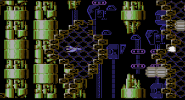
Trick scrolling of the same patterns within few chars[edit | edit source]
The easiest way of parallax scrolling can be found in early games like the game Parallax (1986), where the name already refers to the scrolling-technique. Here the existing bits are being rolled (horizontally) or copied (all directions) within one or several chars so that the parallax-effect is created. The graphics of these background layers often appear to be quite generic.
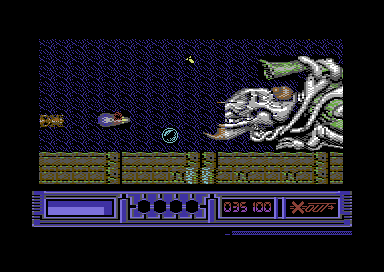
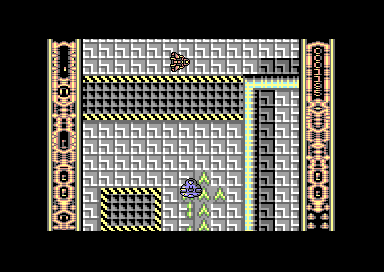
- 1984
- 1985
- 1986
- 1987
- 1988
- 1989
- Abyss
- BMX Freestyle
- Dragon Ninja (level 2 and 5)
- Hard'n'Heavy
- Led Storm
- Menace
- Micro Mouse
- Phobia
- Retrograde
- Rock'n Roll
- Snare (background layer is stable)
- X-Out
- 1990
- 1991
- 1992
- 1993
- 1994
- Boboix (water)
- 1996
- 19??
- 2008
- Enforcer 2 (Preview)
- 2020
Many space-shooters make use of large areas of stars moving at different speeds in the background, which can also create some kind of parallax-effect.
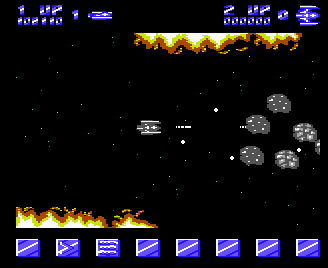
- Lunar Leeper (1982)
- Revenge of the Mutant Camels (1984)
- Iridis Alpha (1986)
- Nemesis (Konami) (1986)
- Delta (1987)
- Hades Nebula (1987)
- Hunter's Moon (1987)
- Leviathan (1987) (stars in the background are stable)
- Super G-Man (1987)
- Wizball (1987)
- Armalyte (1988)
- Bedlam (1988)
- IO – Into Oblivion (1988) (stars in the background are stable; stars are moving in end-sequence)
- Zamzara (1988)
- Zybex (1988)
- Airwolf 2 (1989)
- Forgotten Worlds (1989)
- Head the Ball (1989)
- Katakis (1989)
- Myth (1989) (Shooter-Level: stars are moving, later stable)
- Phobia (1989)
- Saint Dragon (1990)
- Alien World (1991)
- Catalypse (1992)
- Enforcer (1992)
- Lions of the Universe (1993) (stars in the background are stable)
- Soul Force (2020)
- Retaliate (2021)
An exceptional form of large area background animation can be found in several levels of the games Creatures 2 and Quasimodo's Christmas Caper. The gently falling snowflakes are being copied into several chars of a charset. It creates the illusion as if all these snowflakes were individual graphic elements moving individually on the screen.
Layer scrolling by use of raster interrupts (only horizontal)[edit | edit source]
By the use of rasterlines it is possible to display several layers of different speeds. But these layers cannot overlap, which can be recognized in the early game Moon Patrol. The green mountains do not rise up into the area of the grey ones.
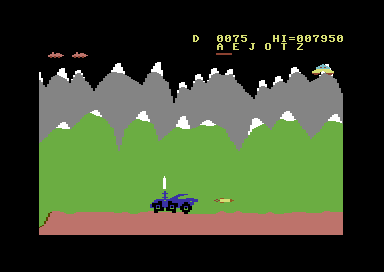
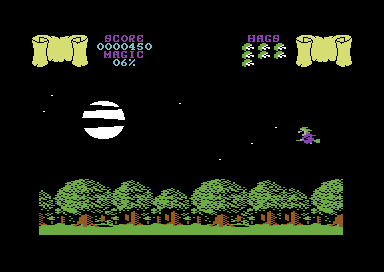
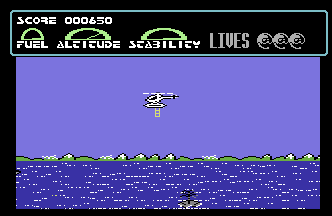
- 1983
- Attack of the Mutant Camels (obere Grafikebene steht)
- Moon Patrol
- B.C.'s Quest for Tires
- 1984
- 3D Beee (jerking)
- African Safari (adventure containing layer scrolling!)
- Battle through Time (upper graphic layer is stable)
- B.C. II - Grog's Revenge
- Billy the Postman (clouds)
- Daley Thompson's Decathlon
- Decathlon
- Dropzone (upper graphic layer is stable)
- Hes Games
- Jinn-Genie (upper graphic layer is stable)
- Mancopter
- The Fall Guy
- Track and Field
- 1985
- Cauldron (upper grafic layer is stable)
- Desert Fox
- Hyper Sports (gymnastics at the vaulting horse, triple jump)
- Imhotep
- Kane (horse riding-levels 2 and 4)
- Tir Na Nog
- 1986
- Chameleon
- Express Rider
- Helikopter Jagd
- Legend of the Amazon Women
- The Way of the Tiger
- Uuno Turhapuro Muuttaa Maalle
- 1987
- Army Moves
- ATV Simulator
- California Games (disciplines: Bmx and Skating)
- Danger Freak
- Dukes of Hazzard
- Galactic Games (discipline: Head Throwing)
- Giana Sisters (clouds)
- Gun Runner
- Hysteria
- Inspector Gadget (Preview)
- Iron Horse
- Mounty Mick's Deathride
- Plasmatron
- Predator
- Run Like Hell
- Star Paws
- The Inheritance (Arcade)
- The Living Daylights
- 1988
- Aquanaut
- Beach Buggy (clouds)
- Caveman Ugh-Lympics
- Daley Thompson's Olympic Challenge
- Daily Double Horse Racing
- Kane 2 (horse riding-levels 1, 3 and 4)
- Navy Moves (level 1)
- Rimrunner
- Stunt Bike Simulator
- Tangent
- The Games: Summer Edition (discipline: hurdling)
- The Games: Summer Edition (discipline: ski-jump, slalom)
- 1989
- 1990
- 1991
- Back to the future III (level 1)
- Wrath of Demon
- 1992
- 1000 Miglia (intro)
- Turbo the Tortoise
- Winter Camp (level 2, 4 and 6)
- 1997
- 2001
- 2020
- Flying Saucer (upper grafic layer is stable)
- 2021
- 2022
- Strikeback (clouds)
- Terrestrial (Level 5)
Parallax scrolling using Sprites[edit | edit source]
Using sprites as background graphics (e.g. trees, clouds, mountains) is another way of creating an additional layer.
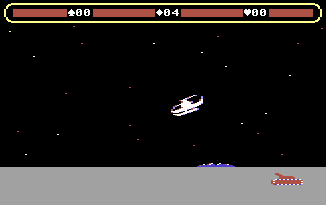
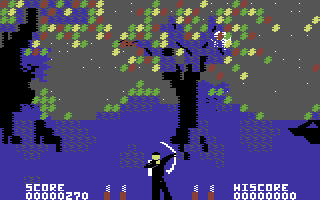
- 1982
- 1983
- 1984
- 1985
- 1986
- 1987
- Battle Valley
- Delta (main graphics layer consists of sprites; parallax-layer with stars are used in the background)
- 1990
- 1991
- Back to the future III (Level 4)
- Road Runner and Wile E. Coyote (Level 2,4,6,8)
- CJ's Elephant Antics (Intro)
- 1997
- 2001
- 2021
- Eye of the Beholder (Intro)
Real parallax scrolling[edit | edit source]
Even though the game Karateka, which was already published in 1984, did not really have real parallax scrolling, it proves to be an early attempt of scrolling a foreground layer in front of a stable background layer (here: a mountain picture). As this concept was realized by copying bitmap-graphics, it heavily slowed down the gameplay. This may have been the reason why this concept has not been used in other games.
It was not until the year 1988 that the game Hawkeye pushed the development of fluent parallax scrolling forward. The concept of the program and its realization was innovative and brillant at the same time. By means of four charsets, which were being switched permanently, it was possible to create the illusion of a stable background layer. While part of the charset, used for the scrolling foreground area of the player, had to be the same in all four charsets, the slow-moving background layer consisted of chars of the four switching charsets, which had to be moved and saved by one multicolor-pixel each. The change of the charsets had to be synchronized against the scrolling of the foreground layer so that the viewer/player would have the illusion as if the background layer would not be moving (even though the charsets are permanently moving in the background of the program).
This impressive concept of programming for Hawkeye showed the way forward to later games, in which real parallax scrolling was used, i.e. two complex graphic layers were scrolling at different speeds.
The only tool for creating levels with parallax scrolling is the GEPA Editor (1994).
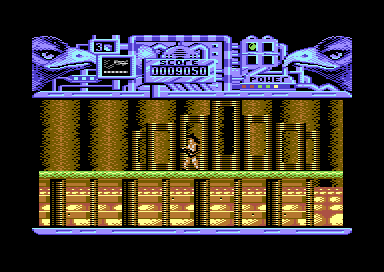
- 1984
- 1988
- 1990
- 1991
- Tales of Boon
- Turrican 2 (shooter-level 3.1)
- Rubicon
- 1992
- 1993
- 199?
- Anasthasia (Preview)
Explanation of parallax scrolling (beginning at minute 1:51)
Mixed forms[edit | edit source]
- Park Patrol (1984) (layer + sprites)
- Alternative World Games (discipline: River Jumping; layer + sprites)
- Energy Warrior (1987) (layer + sprites)
- Train Robbers (1987) (layer + sprites)
- Yogi Bear (1987) (layer + sprites)
- Thundercats (1988) (layer + sprites)
- Foxx Fights Back (1988) (layer + sprites)
- Neverending Story 2 (1990) (layer + sprites)
- F1 Tornado (1991) (layer + char pattern)
- Shadow of the Beast (1991) (layer + sprites + real parallax)
- Rolling Ronny (1992) (layer + sprites)
- Bad Moon Rising (2021)
Special forms[edit | edit source]
- Thunder Blade (1989)
Links[edit | edit source]
| Wikipedia: Parallax |
| Wikipedia: Parallax_scrolling |